Change management techniques are an essential part of any successful organizational transformation. These techniques involve managing and implementing strategies, processes, and practices to ensure a smooth transition from one state to another.
They include both organizational and individual components to maximize the potential of an organization’s transformation.
Change management techniques can vary significantly depending on the organization and the nature of the transformation. However, several common strategies are used across many organizations.
Today we are exploring the seven change management techniques that improve corporate health and negate organizational conflict & also looking at the 7 change management best practices, if you are short in time – read the best practices and make sure to implement them in your next change!
7 Change Management Best Practices
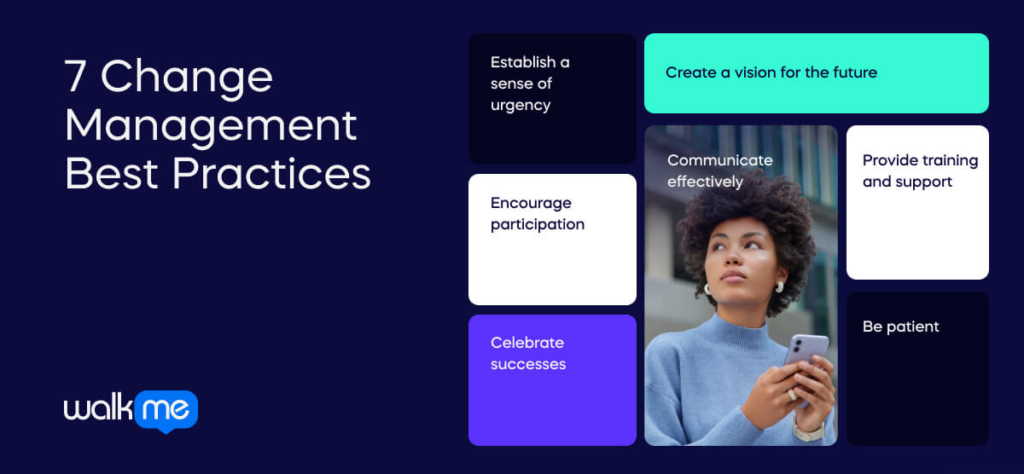
- Establish a sense of urgency: Employees need to understand why the change is necessary and how it will benefit them.
- Create a vision for the future: Employees need to see the end goal and how their individual contributions will help to achieve it.
- Communicate effectively: Employees need to be kept informed of the change throughout the process.
- Encourage participation: Employees need to feel like they have a say in the change and that their input is valued.
- Provide training and support: Employees need the skills and knowledge they need to successfully implement the change.
- Celebrate successes: It is important to recognize and reward employees for their contributions to the change.
- Be patient: Change takes time. It is important to be patient and supportive of employees as they adjust to the new way of doing things.
By following these best practices, you can increase your chances of successfully implementing change in your organization.
Here are some additional tips for implementing change successfully:
- Make sure the change is aligned with the organization’s overall goals and objectives.
- Get buy-in from all levels of the organization, including senior leadership, middle management, and frontline employees.
- Create a detailed plan for implementing the change, and communicate this plan to all stakeholders.
- Be prepared for resistance to change, and have a plan in place to address it.
- Monitor the progress of the change, and make adjustments as needed.
- Celebrate successes along the way.
Change can be a challenging process, but it can also be an opportunity for growth and improvement. By following these best practices, you can increase your chances of successfully implementing change in your organization.
Do You Need a Change Management Process?
“Change almost never fails because it’s too early. It almost always fails because it’s too late.” Writes author and entrepreneur Seth Godin.
We see changes happen all around us, and they’re only coming faster as digitalization increases. A business cannot expect to stay competitive if it can’t keep pace with these changes.
How do you keep up with the status quo in such a volatile business environment? You need robust organizational change management strategies.
It isn’t enough to wait until the need for change arrives. It’s not enough to copy competitors long after they’ve implemented changes.
Proactively managing change requires a carefully cultivated company culture that embraces new ideas.
In this article, we’re sharing change management techniques that improve organizational health. We’ll also cover the principles of Agile change and why it’s the future of change management.
What Is a Change Management Process?
A change management process gets an organization from point A to point B. It outlines the key performance indicators (KPIs) and provides a structured approach to help organizations effectively manage change.
It’s a recipe for success when implementing a change initiative. Any change initiative can be one of two types: adaptive or transformational.
An adaptive change is a minor improvement to an existing business process. For example:
- Creating a new role.
- Enabling two-factor authentication for all employees.
- Adaptive changes make an organization a little better every day.
Transformational changes, however, are major diversions from the status quo. Things like:
- Launching a new program or system, for which you’ll need to provide employee training.
- Migrating from on-premise servers to cloud servers.
These major change projects can take months or years of planning and will have a big impact on day-to-day operations.
The 7 R’s Of Change Management
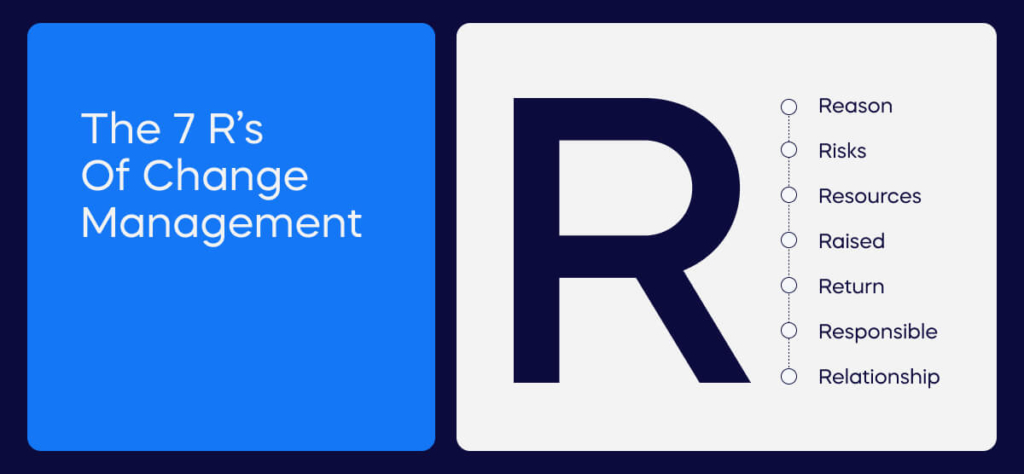
This handy mnemonic serves as a checklist for organizational change management strategies.
This is the least change leaders should consider before the implementation process begins:
- What’s the Reason for the change? – Every change project requires justification, and that must outweigh the cost. Why do you want to be at point B instead of point A? What’s the problem that the proposed change would solve? Sound justification helps get the buy-in of senior leaders.
- What are the Risks? – There are always risks involved with organizational change efforts. What are the potential adverse outcomes? Could the organization lose profits? Could systems go down? Even the best-laid plans can go wrong, and acknowledging the risks helps to mitigate any anticipated resistance.
- What Resources are required? – Which employees are going to do the work? How much is it going to cost? How long is it going to take? Time, money, and staff power are all resources for an organization. Ensure you have the necessary resources and that you’re not wasting any.
- Who Raised the change request? – This isn’t the change manager who facilitated the request. The business leaders should be responsible for the service line the change will affect. This is essential information for key stakeholders. When business leaders attach their names to change requests, there’s less resistance to change from managers and employees.
- What will the Return be? – If successful, what does the organization gain? Increased revenue? More efficient operation? Boosted morale? This differs from the Reason for a change in that it focuses on the outcome, not the problem. Asking this question reassures business leaders that the proposed change is in the organization’s best interests.
- Who is Responsible for the change? – Sometimes, this is the same as the person who requested the change, but not always. More often, it’s the managers of the teams who are doing the work when implementing change. If anything goes wrong, who’s the first person who needs to know? With a transformational change, managers could be responsible for different steps. In that case, it’s best to list one of the change managers as accountable for coordinating the effort.
- What’s the Relationship between this change and other changes? – Take a step back and look at the bigger picture. What are other ongoing changes? You don’t want to create unnecessary work or conflicts. Spotting relationships between changes requires familiarity with an organization’s inner workings— or decent change management software.
Why Change Drives Business Transformation
Consider the common reasons why business transformation initiatives often fail:
- A lack of vision from leadership.
- A need for more engagement from stakeholders.
- A need for adoption by employees.
It’s important to manage change diligently to ensure this doesn’t happen. Following a good change management methodology helps change managers plan every step.
Consider this:
Many businesses experience resistance to change from employees and customers alike. They want things to stay the same.
A suitable change management methodology helps managers and employees understand the wider business strategy and allows customers to embrace change.
The Importance of Agile Organizational Change
The formal approach to change is a “top-down” process. Leadership teams make decisions, create plans, and then communicate changes.
Senior leadership needs to hold all the critical information for this strategy to be effective. The organizational structure needs to have a clear vertical hierarchy.
This is antithetical to the concept of Agile.
An Agile organization eliminates knowledge silos and flattens the hierarchy. Leaders in Agile organizations aren’t expected to hold all the key information needed for major changes.
That’s why the future of successful change management is Agile.
Gartner’s organizational change guidance outlines an “open-source change” strategy that aligns closely with Agile principles. It encourages early transparency and employee-led change, allowing an organization to make faster and adapt quickly.
This strategy is also sometimes referred to as change leadership.
7 Change Management Techniques That Improve Organizational Health
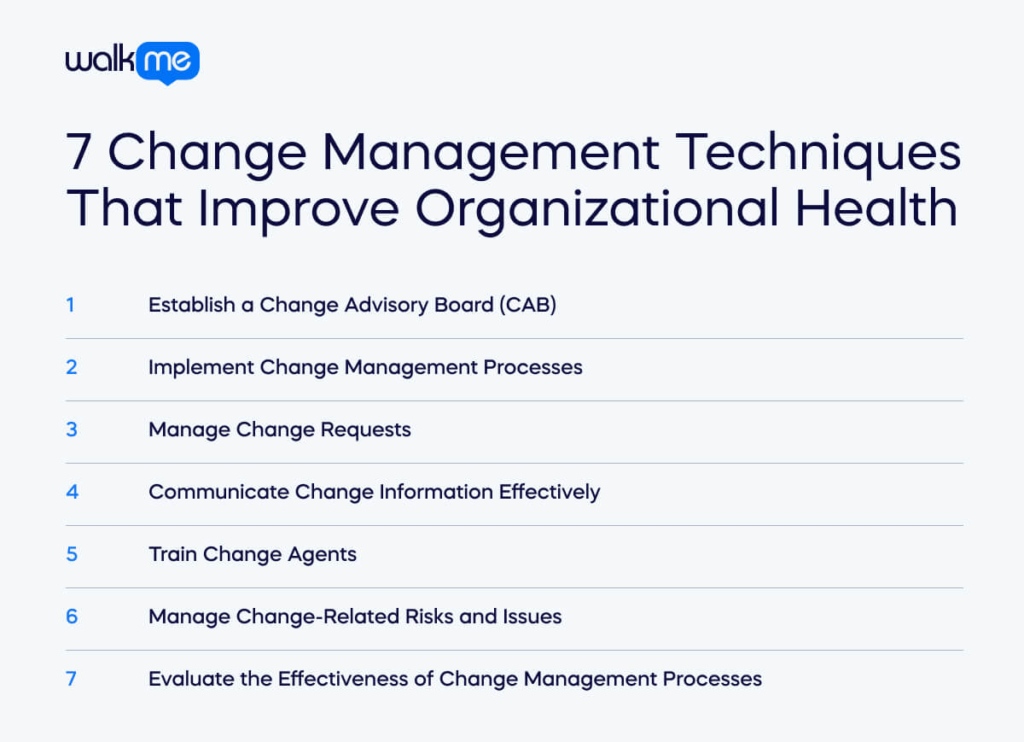
- Establish a Change Advisory Board (CAB)
A CAB is a group of people who assess and authorize each step of a change. A CAB owner, who is familiar with change management strategies, should lead the CAB.
The rest of the CAB members should consist of representatives from every group affected by the change. CAB members act as a bridge between their teams and the CAB.
Having a CAB for major changes is necessary for success. They make all technical considerations and represent all affected teams.
- Implement Change Management Processes
You don’t need to build organizational change management strategies from the ground up. For example, many organizations apply the change management models outlined by ITIL for IT projects and PRINCE2 for non-IT projects.
There are many methods out there that organizations can adopt and adapt according to their needs, and most leaders want to learn new skills for managing organizational change.
Provide training on change management strategies to all employees. This is one of the best ways leaders can encourage a positive shift in a company’s culture.
- Manage Change Requests
Documenting and managing change requests beings by considering the 7 R’s and assessing whether the change is worthwhile and in scope. It’s also important to attach a priority to change requests so that you can focus on the most beneficial and relevant changes first.
Document all change initiatives. Even rejected ones.
It can be helpful to have software-based tools to help you manage change effectively.
- Communicate Change Information Effectively
Keeping communication open is the single most important technique to improve organizational health.
The goal is to get stakeholder buy-in and encourage adoption, so communication should be early and clear. Share the vision for significant changes, and craft a story that non-technical stakeholders can follow.
Make it clear what the path ahead looks like, as best you can. Keep communicating throughout the change process to reassure stakeholders you’re heading in the right direction.
Celebrate milestones during transformational changes and continue to retell the story as it develops. Effective communication is the glue in times of uncertainty generated by major changes. Without it, things will fall apart.
- Train Change Agents
Change agents, also known as change champions, advocate for change within your organization. They are constantly looking for new ways of doing things, usually doing so on top of their normal role.
A network of change agents distributed throughout an organization is an excellent way to promote change-positive culture. It also helps engage less enfranchised teams.
- Manage Change-Related Risks and Issues
Identifying risks and issues as early as possible is a necessary process.
Those who oppose the change will use it against you if you don’t do it. Be open and honest. You should have plans to deal with any common issues proactively.
Most of all, you should have a contingency plan. More considerable risks are easier to stomach if there is a clear rollback plan or alternative path.
- Evaluate the Effectiveness of Change Management Processes
Organizational change itself is a business process that is not exempt from change. Change management teams should lead the way by following Continual Service Improvement (CSI) principles.
Remember to measure qualitative and quantitative data when assessing the effectiveness of any business processes.
Determine key performance indicators for changes. Collect feedback from focus groups to see how they felt about the change process. Learn from both success and failure.
The Key Elements of an Agile Change Initiative
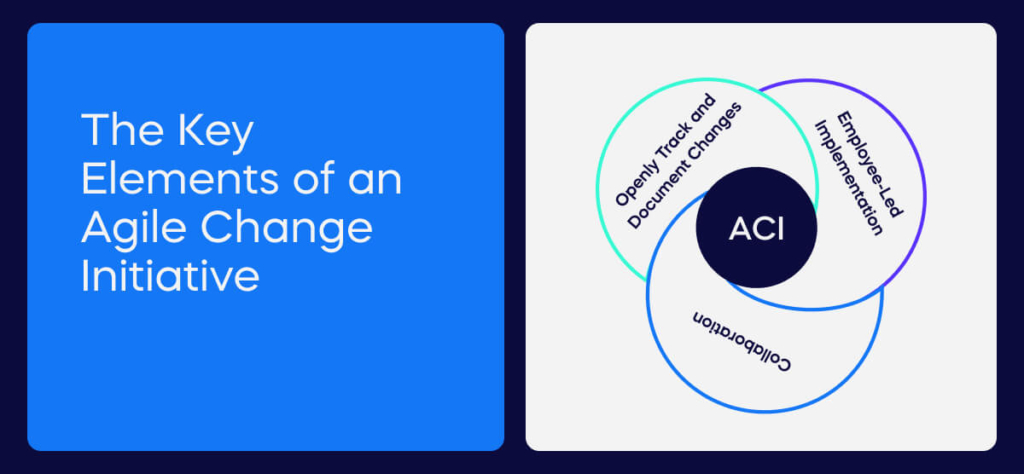
Even a robust change management process could benefit from being more agile.
These are the key elements of an agile change strategy and how they differ from a traditional strategy:
Collaboration
Change leads to success when employees at every level provide valuable input. A formal change strategy focuses on collecting feedback after making changes, whereas an Agile strategy collects feedback first to make better-educated decisions.
Good collaboration requires:
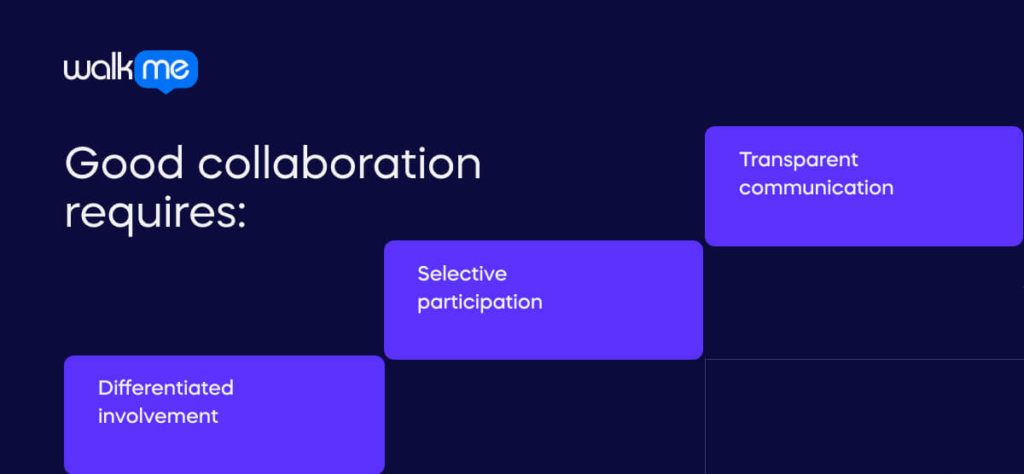
Transparent communication – Share your vision early, and outline plans long before they unfold. Even if you don’t have all the answers, communicate ideas as early as possible.
Selective participation – Don’t include everyone, only representatives from teams that the change affects. This will help cut out the noise.
Differentiated involvement – CAB and gate meetings are a narrow way to gather input. Be prepared to use different methods for different teams and situations.
Employee-Led Implementation
Leaders are often disconnected from the workforce and don’t know what changes to make. Having employees lead change efforts allows for faster and more relevant changes.
The role of leaders should be to share a vision and provide guidance. Employees should handle the rest.
Openly Track and Document Changes
Track everything in a change management tool that everyone can access.
Support teams will be the first to notice any unexpected issues caused by a change, and the sooner they can find a relationship between a problem and a change, the sooner they can find a solution.
Using software-based tools to support change is highly recommended.
What Comes Next? Rethinking Organizational Change
Gone are the days when leaders could manage every step of every organizational change.
Knowledge work has evolved to a point where there’s too much data for leaders to have all the key information.
The near future is unpredictable, and having a plan isn’t worth much if you can’t adapt to change.
The future of change is open, agile, and collaborative. Employees who understand the reality of business processes because they live it every day are the ones who drive Agile change.
Improving organizational health for the long-term means embracing:
- Open and early communication.
- Employee-led change.
- Diligent documentation.
And finally, remember that many adaptive changes made one after the other are preferable to a major transformational change made only once. Little and often is the key.
Frequently Asked Questions
Without a dedicated team, organizations can still implement effective change by leveraging cross-functional task forces, engaging key stakeholders early, and utilizing structured frameworks like ADKAR or Kotter’s 8-Step to guide the process.
Data analytics enables organizations to monitor change adoption, identify resistance points, and measure the impact of change initiatives in real-time, facilitating informed decision-making and timely adjustments.
Change management should be embedded from the outset of digital transformation projects, during the planning phase, to ensure alignment with organizational goals, stakeholder engagement, and to proactively address potential resistance.
Engaging stakeholders fosters trust, ensures their concerns are addressed, and increases buy-in, which is vital for the successful implementation and sustainability of change initiatives.
Change management techniques facilitate cultural transformation by promoting open communication, aligning behaviors with organizational values, and reinforcing desired changes through consistent practices and leadership support.

